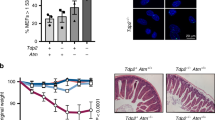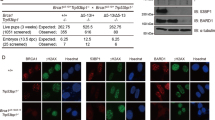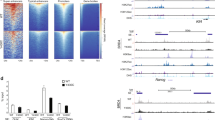Abstract
Bloom syndrome and ataxia-telangiectasia are autosomal recessive human disorders characterized by immunodeficiency, genome instability and predisposition to develop cancer. Recent data reveal that the products of these two genes, BLM and ATM, interact and function together in recognizing abnormal DNA structures. To investigate the function of these two molecules in DNA damage recognition, we generated double knockouts of ATM−/− BLM−/− in the DT40 chicken B-lymphocyte cell line. The double mutant cells were viable and exhibited a variety of characteristics of both ATM−/− and BLM−/− cells. There was no evidence for exacerbation of either phenotype; however, the more extreme radiosensitivity seen in ATM−/− and the elevated sister chromatid exchange seen in BLM−/− cells were retained in the double mutants. These results suggest that ATM and BLM have largely distinct roles in recognizing different forms of damage in DNA, but are also compatible with partially overlapping functions in recognizing breaks in radiation-damaged DNA.
This is a preview of subscription content, access via your institution
Access options
Subscribe to this journal
Receive 50 print issues and online access
$259.00 per year
only $5.18 per issue
Buy this article
- Purchase on Springer Link
- Instant access to full article PDF
Prices may be subject to local taxes which are calculated during checkout






Similar content being viewed by others
References
Ababou M, Dutertre S, Lecluse Y, Onclercq R, Chatton B and Amor-Gueret M . (2000). Oncogene, 19, 5955–5963.
Abraham RT . (2001). Genes Dev., 15, 2177–2196.
Arlett CF and Lehmann AR . (1979). Acta Biol. Med. Ger., 38, 1277–1283.
Aurias AB, Dutrillaux DB and Lejeune J . (1980). Mutat. Res., 69, 369–374.
Bakkenist CJ and Kastan MB . (2003). Nature, 421, 499–506.
Banin S, Moyal L, Shieh S, Taya Y, Anderson CW, Chessa L, Smorodinsky NI, Prives C, Reiss Y, Shiloh Y and Ziv Y . (1998). Science, 281, 1674–1677.
Beamish H, Kedar P, Kaneko H, Chen P, Fukao T, Peng C, Beresten S, Gueven N, Purdie D, Lees-Miller S, Ellis N, Kondo N and Lavin MF . (2002). J. Biol. Chem..
Beamish H and Lavin MF . (1994). Int. J. Radiat. Biol., 65, 175–184.
Bezzubova O, Silbergleit A, Yamaguchi-Iwai Y, Takeda S and Buerstedde JM . (1997). Cell, 89, 185–193.
Buscemi G, Savio C, Zannini L, Micciche F, Masnada D, Nakanishi M, Tauchi H, Komatsu K, Mizutani S, Khanna K, Chen P, Concannon P, Chessa L and Delia D . (2001). Mol. Cell. Biol., 21, 5214–5222.
Canman CE, Lim DS, Cimprich KA, Taya Y, Tamai K, Sakaguchi K, Appella E, Kastan MB and Siliciano JD . (1998). Science, 281, 1677–1679.
Celeste A, Petersen S, Romanienko PJ, Fernandez-Capetillo O, Chen HT, Sedelnikova OA, Reina-San-Martin B, Coppola V, Meffre D, Difilippantonio MJ, Redon C, Pilch DR, Olaru A, Eckhaus M, Camerini-Otero RD, Tessarollo L, Livak F, Manova K, Bonner WM, Nussenzweig MC and Nussenzweig A . (2002). Science, 296, 922–927.
Chaganti RS, Schonberg S and German J . (1974). Proc. Natl. Acad. Sci. USA, 71, 4508–4512.
Chen P, Gatei M, O'Connell MJ, Khanna KK, Bugg SJ, Hog A, Scott SP, Hobson K and Lavin MF . (1999). Oncogene, 18, 249–256.
Chen PC, Lavin MF, Kidson C and Moss D . (1978). Nature, 274, 484–486.
Chester N, Kuo F, Kozak C, O'Hara CD and Leder P . (1998). Genes Dev., 12, 3382–3393.
Cornforth MN and Bedford JS . (1985). Science, 227, 1589–1591.
Cortez D, Wang Y, Qin J and Elledge SJ . (1999). Science, 286, 1162–1166.
Dong Z, Zhong Q and Chen PL . (1999). J. Biol. Chem., 274, 19513–19516.
Dutertre S, Ababou M, Onclercq R, Delic J, Chatton B, Jaulin C and Amor-Gueret M . (2000). Oncogene, 19, 2731–2738.
Ellis NA, Groden J, Ye TZ, Straughen J, Lennon DJ, Ciocci S, Proytcheva M and German J . (1995). Cell, 83, 655–666.
Ellis NA, Proytcheva M, Sanz MM, Ye TZ and German J . (1999). Am. J. Hum. Genet., 65, 1368–1374.
Essers J, Hendriks RW, Swagemakers SM, Troelstra C, de Wit J, Bootsma D, Hoeijmakers JH and Kanaar R . (1997). Cell, 89, 195–204.
Foray N, Priestley A, Alsbeih G, Badie C, Capulas EP, Arlett CF and Malaise EP . (1997). Int. J. Radiat. Biol., 72, 271–283.
Franchitto A and Pichierri P . (2002). J. Cell Biol., 57, 19–30.
Fukao T, Kaneko H, Birrell G, Gatei M, Tashita H, Yoshida T, Cross S, Kedar P, Watters D, Khanna KK, Misko I, Kondo N and Lavin MF . (1999). Blood, 94, 1998–2006.
Gatei M, Young D, Cerosaletti KM, Desai-Mehta A, Spring K, Kozlov S, Lavin MF, Gatti RA, Concannon P and Khanna K . (2000). Nat. Genet., 25, 115–119.
Gaymes TJ, North PS, Brady N, Hickson ID, Mufti GJ and Rassool FV . (2002). Oncogene, 21, 2525–2533.
German J . (1993). Medicine, 72, 393–406.
Gueven N, Keating KE, Chen P, Fukao T, Khanna KK, Watters D, Rodemann PH and Lavin MF . (2001). J. Biol. Chem., 276, 8884–8891.
Hand R and German J . (1975). Proc. Natl. Acad. Sci. USA, 72, 758–762.
Houldsworth J and Lavin M . (1980). Nucleic Acids Res., 8, 3709–3720.
Imamura O, Fujita K, Shimamoto A, Tanabe H, Takeda S, Furuichi Y and Matsumoto T . (2001). Oncogene, 20, 1143–1151.
Karow JK, Constantinou A, Li JL, West SC and Hickson ID . (2000). Proc. Natl. Acad. Sci. USA, 97, 6504–6508.
Kim ST, Xu B and Kastan MB . (2002). Genes Dev., 16, 560–570.
Kitao S, Shimamoto A, Goto M, Miller RW, Smithson WA, Lindor NM and Furuichi Y . (1999). Nat. Genet., 22, 82–84.
Kozlov S, Gueven N, Keating K, Ramsay J and Lavin MF . (2003). J. Biol. Chem., 278, 9309–9317.
Lavin MF and Lederman HM . (2003). Immunologic Disorders in Infants and Children, Erstiehm, Ochs HD, Winkelstein JA (eds). Harcourt Health Sciences: Philadelphia, (in press).
Lavin MF and Shiloh Y . (1997). Annu. Rev. Immunol., 15, 177–202.
Lim J, Yang C, Hong SJ and Kim KS . (2000). Mol. Cell. Biochem., 212, 51–60.
Lonn U, Lonn S, Nylen U, Winblad G and German J . (1990). Cancer Res., 50, 3141–3145.
Luo CM, Tang W, Mekeel KL, DeFrank JS, Anne PR and Powell SN . (1996). J. Biol. Chem., 271, 4497–4503.
Luo G, Santoro IM, McDaniel LD, Nishijima I, Mills M, Youssoufian H, Vogel H, Schultz RA and Bradley A . (2000). Nat. Genet., 26, 424–429.
Meyn MS . (1993). Science, 260, 1327–1330.
Morrison C, Sonoda E, Takao N, Shinohara A, Yamamoto K and Takeda S . (2000). EMBO J., 19, 463–471.
Pandita TK and Hittelman WN . (1994). Mutat. Res., 310, 1013.
Savitsky K, Bar-Shira A, Gilad S, Rotman G, Ziv Y, Vanagaite L, Tagle DA, Smith S, Uziel T and Sfez S . (1995). Science, 268, 1749–1753.
Shiloh Y and Kastan MB . (2001). Adv. Cancer Res., 83, 209–254.
Stewart GS, Maser RS, Stankovic T, Bressan DA, Kaplan MI, Jaspers NG, Raams A, Byrd PJ, Petrini JH and Taylor AM . (1999). Cell, 99, 577–587.
Takao N, Kato H, Mori R, Morrison C, Sonada E, Sun X, Shimizu H, Yoshioka K, Takeda S and Yamamoto K . (1999). Oncogene, 18, 7002–7009.
Taniguichi T, Garcia-Higuera I, Xu B, Andreassen PR, Gregory RC, St K, Lane WS, Kastan MB and D'Andrea AD . (2002). Cell, 109, 459–472.
Taylor AM, Metcalfe JA, Oxford JM and Harnden DG . (1976). Br. J. Radiol., 49, 561.
Wang W, Seki M, Narita Y, Sonoda E, Takeda S, Yamada K, Masuko T, Katada T and Enomoto T . (2000a). EMBO J., 19, 3428–3435.
Wang Y, Cortez D, Yazdi P, Neff N, Elledge SJ and Qin J . (2000b). Genes Dev., 14, 927–939.
Wu L, Davies SL, Levitt NC and Hickson ID . (2001). J. Biol. Chem., 276, 19375–19381.
Yamagata K, Kato J, Shimamoto A, Goto M, Furuichi Y and Ikeda H . (1998). Proc. Natl. Acad. Sci. USA, 95, 8733–8738.
Yazdi PT, Wang Y, Zhao S, Patel N, Lee EY and Qin J . (2002). Genes Dev., 16, 571–582.
Yu CE, Oshima J, Fu YH, Wijsman EM, Hisama F, Alisch R, Matthews S, Nakura J, Miki T, Ouais S, Martin GM, Mulligan J and Schellenberg GD . (1996). Science, 272, 258–262.
Zampetti-Bosseler F and Scott D . (1981). Int. J. Radiat. Biol. Relat. Stud. Phys. Chem. Med., 39, 547–558.
Zhao S, Weng YC, Yuan SS, Lin YT, Hsu HC, Lin SC, Gerbino E, Song MH, Zdzienicka MZ, Gatti RA, Shay JW, Ziv Y, Shiloh Y and Lee EY . (2000). Nature, 405, 473–477.
Acknowledgements
We thank Aine Farrell for technical support and Tracey Laing for typing this manuscript. Support was provided by the Australian National Health and Medical Research Council, the A-T Children's Foundation, the National Institutes of Health USA, the Australia–Japan Co-operative Research Program and the Uehara Research Foundation.
Author information
Authors and Affiliations
Corresponding author
Rights and permissions
About this article
Cite this article
Fukao, T., Chen, P., Ren, J. et al. Disruption of the BLM gene in ATM-null DT40 cells does not exacerbate either phenotype. Oncogene 23, 1498–1506 (2004). https://doi.org/10.1038/sj.onc.1207276
Received:
Revised:
Accepted:
Published:
Issue Date:
DOI: https://doi.org/10.1038/sj.onc.1207276



